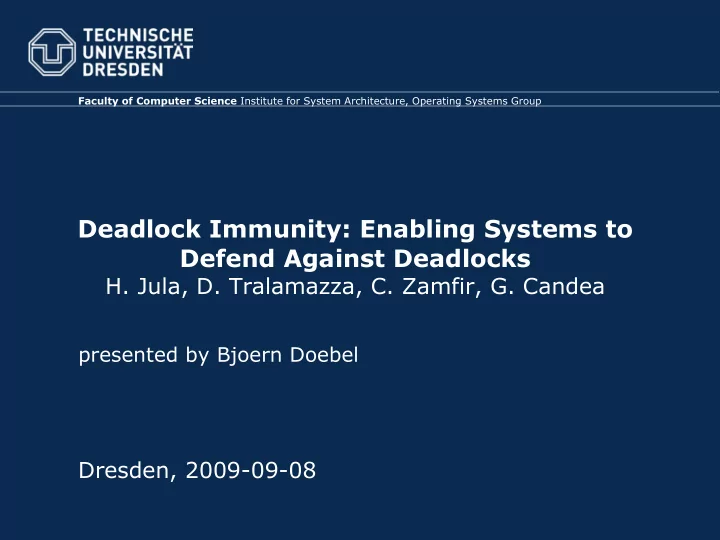

Faculty of Computer Science Institute for System Architecture, Operating Systems Group Deadlock Immunity: Enabling Systems to Defend Against Deadlocks H. Jula, D. Tralamazza, C. Zamfir, G. Candea presented by Bjoern Doebel Dresden, 2009-09-08
Deadlocks TU Dresden, 2009-09-08 Slide 2 von 11
Deadlock bugs • Study [16] (105 bugs, 31 deadlocks) – “Some 22% of the deadlock bugs are caused by one thread acquiring resource held by itself.” – “Almost all (97%) of the examined deadlock bugs involve two threads circularly waiting for at most two resources.” – “Many (61%) of the examined deadlock bugs are fixed by preventing one thread from acquiring one resource. Such fix can introduce non-deadlock concurrency bugs.” TU Dresden, 2009-09-08 Slide 3 von 11
Deadlock avoidance done wrong TU Dresden, 2009-09-08 Slide 4 von 11
Doing it (more) right - Dimmunix TU Dresden, 2009-09-08 Slide 5 von 11
Resource Allocation Graph TU Dresden, 2009-09-08 Slide 6 von 11
Avoiding Deadlocks • When DL is found: – Store “deadlock signature” of participating threads & wait for some recovery to happen. • Later runs: – For each lock acquisition: check whether this would lead to a previously seen deadlock state – If so, make calling thread yield until at least one other participant has released its locks. – May lead to starvation – yield cycles. TU Dresden, 2009-09-08 Slide 7 von 11
Performance & Applicability • Able to find & cure real-world deadlock bugs. • Between 2 and 7 % runtime overhead. • Lock throughput benchmark: – 4.5% overhead for pthreads, 17.5% for Java • Overhead mostly from data updates and avoidance code. – Automatic calibration of signature stack depth – false positives vs. performance TU Dresden, 2009-09-08 Slide 8 von 11
Remarks • Signatures are control-flow based, w/o regarding data – false positives: update(a,b) update(c,d) .. <--> .. update(b,a) update(d,c) update(x,y) { lock(x); lock(y); .. unlock(x); unlock(y); } TU Dresden, 2009-09-08 Slide 9 von 11
More remarks • Why can't we find those bugs before deploying? – Static source code analysis RacerX → • But: need access to source code – Static binary analysis • hard – Dynamic analysis Valgrind Thread Checker → • RAG: request vs. allow edges? TU Dresden, 2009-09-08 Slide 10 von 11
Back to [16] – “Some 22% of the deadlock bugs are caused by one thread acquiring resource held by itself.” • Ignored due to availability of other mechanisms (non-recursive pthreads) – “Almost all (97%) of the examined deadlock bugs involve two threads circularly waiting for at most two resources.” • Means that real-world RAGs are not that complex. – “Many (61%) of the examined deadlock bugs are fixed by preventing one thread from acquiring one resource. Such fix can introduce non-deadlock concurrency bugs.” • Need to handle yield cycles. TU Dresden, 2009-09-08 Slide 11 von 11
Recommend
More recommend